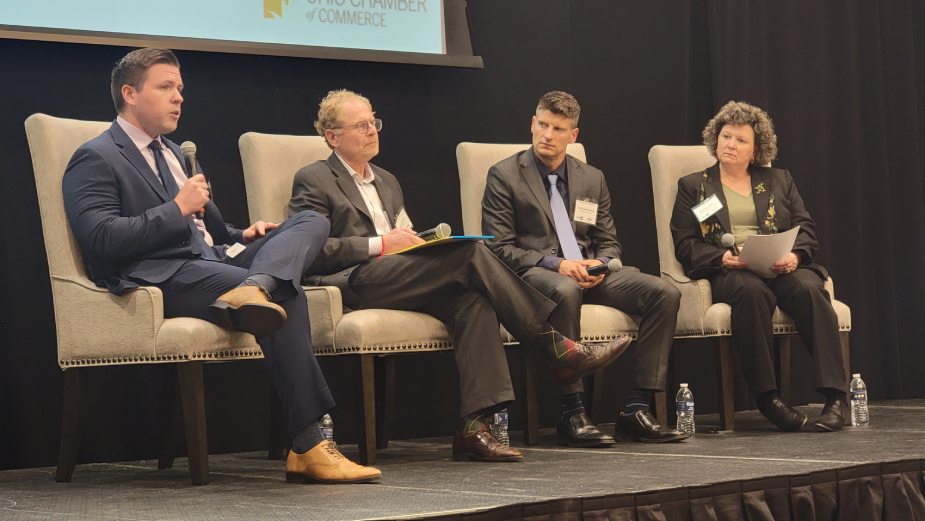Brookfield Students Get Hands-On in Pre-Apprenticeship
BROOKFIELD TOWNSHIP, Ohio – For the first time in years, students at Brookfield High School are putting down their notebooks and picking up hammers and circular saws.
This year, the school launched a two-year pre-apprenticeship class that introduces students to woodworking. Like a traditional wood shop class, students learn safety fundamentals, how to handle hand and power tools, and how to read a project plan.
What’s different is graduates who complete the program earn an industry-recognized credential that allows them to enter an apprenticeship program with the carpenters union or other participating unions.
For Codi Hoover, a senior at Brookfield, the class offers a jumpstart to follow in his father’s footsteps.
“My dad was always a big construction guy and I was always around this stuff as a kid,” Hoover says. “So I thought it was a great opportunity to learn even more about it.”

Hoover plans to work as an electrician and says skills gained in the pre-apprenticeship class will aid him in the long run.
He says he has a better idea of how much goes into even a simple birdhouse project.
Brookfield doesn’t offer other shop classes. So as a senior, this was Hoover’s only chance to get any kind of hands-on training, he says. He jumped at the opportunity.
“I look forward to coming to school for it,” he says. “It’s just a great thing to have.”
The class is the result of a partnership with the Indiana Kentucky Ohio Regional Council of Carpenters, The Builders Association of Eastern Ohio and Western Pennsylvania and the Educational Service Center of Eastern Ohio.
Each project is broken down into step-by-step instructions, says Robert Eggleston, lead career counselor at the ESC. Students learn to safely use hand tools, as well as miter saws, table saws, circular saws and impact drills.
“Every single measurement, every tool that you can imagine that they would use in their trade,” Eggleston says. “The kids are able to go through and learn. And as they’re learning it, they’re building projects.”
Students will complete eight or nine projects this year. Each project is designed as if on a job site, but scaled down for the classroom. Projects start simple – birdhouses and toolboxes – and get progressively more difficult.
On this day, students were putting the finishing touches on cornhole boards they had spent a few weeks working on.
The boards will be posted online for sale for about $85 a set, Eggleston says.
“Then they’re going to take that money and put it right back into the classroom,” he says.
Of the 45 enrolled in this first year, about 10 are interested in joining the trades after high school, says Adam Hughes, pre-apprenticeship class instructor. Most of the students had no experience with wood work and wanted to try something new, he says.
Launching the program was important for those interested in the trades because they didn’t want to attend a career and technical school, Hughes says.
“They wanted to stay in the home school, and we didn’t have this program for them,” he says.
For the seniors in particular, the school had to fast-track the two-year program into one year so they could earn the credential before graduating.
Typically, students in the second year of the program have a chance to take lessons from special guest industry professionals who also discuss recruitment opportunities for jobs after graduation.
“This first year, we’re doing a condensed version simply because we already have seniors who are in here and they’re looking to get into trades,” the ESC’s Eggleston says. “So we’re going to try to get them as many of those skills as possible before they go.”
TJ Laverty, a senior, took the class because his dad was a carpenter. “I wanted to learn the stuff that he learned,” says Laverty, who is interested in carpentry and HVAC work after high school.
During the projects, Laverty says he’s learned the value of teamwork. For the cornhole boards, students worked in pairs. “That will help me work with other people in the future,” he says.
For the students who aren’t interested in pursuing the trades, Hughes says the class is valuable because of the skills gained, including practical carpentry skills and problem solving.
“If they hit a problem, we just tell them, ‘You have to figure out how to fix that,’ ” he says. So they’re problem solving. It’s a big thing and it’s working.”
Seniors Alison Breighner and Abby Hill aspire to be a teacher and a flight attendant, respectively, but they agree that having the skills will be beneficial later in life.

“I personally have always done projects around my house with my dad, and I thought it would be a cool skill just to know, even if I don’t go into it,” Breighner says.
Hill plans to build her own tiny house, she says. “So I definitely need all of these skills.
“I think anyone can get into this,” Hill says. “We all start somewhere and most of us will need these skills to do something in our lives. I think we should all take a class like this.”
The class was a priority for Principal Kristen Foster. In the 22 years she’s worked in the district, Brookfield has developed college prep courses for college-bound students and regular students who weren’t sure, but nothing to give students employability skills, she says.
“We made this financial investment and commitment because it’s something I truly believe in,” Foster says. “They’re not just working on carpentry and construction skills, but they are able to get experience and exposure to a varied amount of trades, so they have some options when they leave here.
“We want them to walk out of here with employability skills, whether they’re going to college, or whether we went to a trade school, or they’re going right into the workforce.”
Brookfield financed the class using funds from an Expanding Opportunities for Each Child Grant as well as a portion of the $150,000 RemoteEdX grant awarded to the ESC that was divided between 10 regional schools, according to Foster.
This pre-apprenticeship class also addresses a shift in American culture away from the idea that every student had to be pushed toward college to get a degree, says Kenny Iser, who instructs the class with Hughes.
“There’s a lot of kids out there that don’t want to go to college. They don’t want to pay all that money,” Iser says. “Pushing the kids in a direction where they can discover a trade that they’re interested in has been very rewarding as an educator.”
Iser, who also teaches history at the school and builds furniture in his spare time, says the class gives students a deeper perspective on additive manufacturing and 3D printing, which they can apply to the new MakerSpace across the hall.
“We’re showing them how those machines got their start just doing stuff by hand,” he says. “It sparks some sort of creativity.”
The school district also found ways to get other classes involved, particularly with the cornhole board project.
Students in the career-based intervention program are helping to market and sell the boards, and students in the MakerSpace are creating logos for the boards. Healthy lifestyle students sew the beanbags to be sold with the boards.
Future plans include expanding the shop space from a small room near the school’s MakerSpace into a renovated portion of the existing library. The high school library also will be relocated, Foster says.
Expansion will allow students to work with bigger tools and saws, and complete larger projects, Hughes notes.
Grants from the Ohio Department Education will allow Brookfield to add Certified Logistics Technician, Certified Production Technician, and Robotics and Drones courses to its catalog, Foster adds.
“We’re going to be expanding those programs and maybe bring in some other pre-apprenticeship programs next year,” she says.
Pictured at top: Pre-apprenticeship class instructor Adam Hughes demonstrates painting techniques with seniors Brandon Smith and Domonique McCoy-Parks. Proceeds from cornhole board sales will benefit the class.
Copyright 2024 The Business Journal, Youngstown, Ohio.



